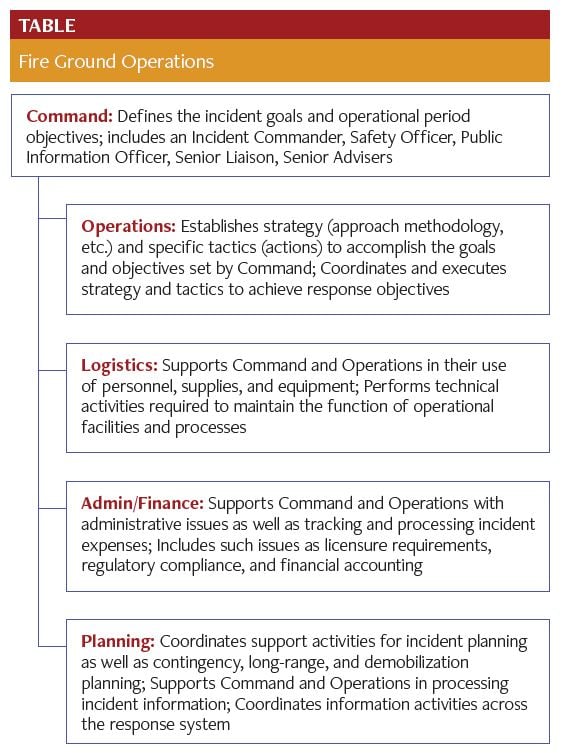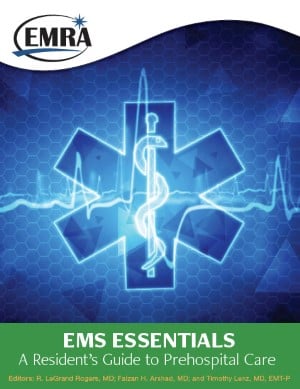Ch 13. Subspecialty: Fire Ground
The fire ground is an inherently dangerous environment, and although seemingly chaotic, there is a surprising amount of or- ganization to a fire scene. Much of the organization is standard across the fire service, while some is specific to the type of fire being fought.
Fire Operations
Incident Command System (ICS): The fire service follows the FEMA ICS structure when on calls. This system is adaptable for large and small incidents. The Incident Commander (IC) typi- cally is the most senior officer on scene.
Chain of Command
- Chief: The overall commander of the fire department.
- Assistant or Deputy Chief: Helps the chief with administrative duties.
- Battalion Chief: Tactical commander of several stations.
- Captain: Commander of a station and apparatus.
- Lieutenant: Not present in many departments; often in command of a specific apparatus within a company if multiple apparatus are at one station.
- Firefighter: The “rank and file.” Specific operations roles may be subdivided.
- Personnel Accountability System (PAS): A means of tracking who is on scene and where they are. This is achieved by each responder placing a nameplate or tag on a larger tag for their apparatus, which is given to the IC when checking
- in at a scene. Some departments use an electronic version of PAS. (Table)

Fire Apparatus
The engineer or driver of the apparatus is responsible for that vehicle and everything it carries. Nobody takes equipment from the fire apparatus without being told to do so and without in- forming the engineer.
- Engine (aka pumper): Pumps the water and carries hose
- Truck (aka ladder): Carries ladders and rescue gear
- Combination: Apparatus that combine engine and truck functions
- Brush: Wildland apparatus
- Tanker: Large water tank apparatus used for scenes with limited water supply
- Utility: Contains equipment for support operations, such as generators, lighting, and extra SCBA bottles
- Heavy Rescue: Carries equipment for heavy technical rescue like trench, high-angle, vehicle extrication, and confined space
- Haz-mat: Carries equipment for containment and decontamination of hazardous material scenes
Helmet Color Coding
Helmet color coding aids in rapid identification of roles on a scene. Many departments use specific helmets for certain per- sonnel.
- White: Chief
- Red: Captain
- Others: Departments may decide to code the engineers, firefighters, paramedics, and support personnel with different colors, including yellow, black, blue, and green
Structure Fire
- Sides of building: The street side (front) of a building is referred to as the A or alpha side. Subsequent sides are named in clockwise order around the building; B (bravo), C (charlie), D (delta).
- Hose safety: Use caution when standing near hoselines. As water is flowing into a hose, or being charged, they can move rapidly and cause injury.
- Teams: Depending on the nature of the call, various tactical teams may be formed.
- Suppression: Primarily hose teams; can be interior or exterior.
- Ventilation: Remove heat and smoke by using fans or cutting holes in the roof.
- RIC/RIT: Rapid Intervention Crew/Team is charged with being ready to rescue downed firefighters at all times.
- Collapse zones: Standard “safe distance” from a building prone to collapse; 1½ times building height.
Wildland Fire
- Air Support
- Planes are used to drop retardant in front of an advancing fire line. Some firefighters parachute into remote locations.
- Helicopters are used to drop water on hotspots and crews in strategic locations.
- Line Crew: Firefighters use hand tools and machinery to cut fire lines or breaks in fuel to slow or stop fire spread. They may also light smaller, controlled fires called back burns to remove fuel prior to the main fire reaching critical structures.
- Operational zone: Sectors are named using letters to track where resources are deployed and fire progresses.
Medical Considerations
- Heat exposure: Temperatures inside homes can reach above 1000 degrees Fahrenheit. Limiting exposure to this heat, as well as effective means of cooling firefighters, is essential.
- Dehydration: Hard work in heavy gear leads rapidly to dehydration and worsens risk of heat illness.
- Hypothermia: Fires that occur in the winter create risk of hypothermia as firefighters leave a building wet and warm, and subsequently cool rapidly.
- Cardiovascular disease: This is still the leading cause of death among firefighters. Some are relatively sedentary until placed on the fireground, where they strenuously exert themselves.
Other Fireground Terms
- Company: A crew under a Captain’s command
- Platoon: Comprised of multiple companies under a Battalion Chief’s command
- LDH: Large Diameter Hose; Hose greater than 3 inches in diameter typically used to supply fire engines
- SCBA: Self Contained Breathing Apparatus; a firefighter’s air supply. Typically contains 30 to 45 minutes of air.
- PASS: Personal Alert Safety System; a device that alerts when a firefighter is motionless for a period of time or when air
- is low in the SCBA to aid the RIC/RIT in locating the downed firefighter quickly.
- Turnout or Bunker gear: A firefighter’s personal protective equipment. Protects from both thermal injury during firefighting operations and contact injury from debris during extrication or other rescue operations.
- Shift: Most departments are staffed by three rotating shifts of firefighters—A, B, and C. Each shift is often referred to as a Platoon.
- Bay: A garage at the station where fire apparatus are kept
- Fire Classes
- Class A—Ordinary Combustibles (wood, paper, cloth, etc.)
- Class B—Liquids and Gases
- Class C—Energized electrical equipment
- Class D—Combustible metals
- Foam: Mixture of water and soap-like chemicals to cool fuel more effectively by decreasing water surface tension to improve penetration into fuel. Can be used in most firefighting applications.
- Aqueous Film Forming Foam (AFFF)—Most common type of foam. Forms films over Class B fuels to aid in smothering fire. Also dilutes Class B fuels.
- Compressed Air Foam System (CAFS)—Combines foam mixture and air to make a shaving cream-like substance that is used in similar applications as AFFF.
- ARFF: Aircraft Rescue and Fire Fighting; specialized form of firefighting for airports.
- NFPA: National Fire Protection Association; governing body for fire service operations and training.
References
- Essentials of Fire Fighting, 6th Edition (2013). IFSTA (International Fire Science Training Association). Fire Protection Publishers.





